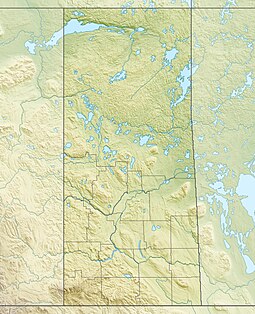| Duck Mountain Provincial Park | |
|---|---|
 Madge Lake | |
| Location | RM of Cote No. 271 & RM of St. Philips No. 301, Saskatchewan, Canada |
| Nearest town | Kamsack |
| Coordinates | 51°41′N 101°38′W / 51.683°N 101.633°W |
| Area | 150 km2 (58 sq mi) |
| Established | 1931 |
| Governing body | Saskatchewan Parks |
| Website | website |
 | |
Duck Mountain Provincial Park[1] is a provincial park, located in the Canadian province of Saskatchewan 14 kilometres (8.7 mi) east of the town of Kamsack and stretches about 12 kilometres (7.5 mi) eastward to the Saskatchewan / Manitoba boundary. The park covers approximately 150 km2 (58 sq mi). Road access to the park is via Highway 57, which connects Saskatchewan Highway 5 to Manitoba Highway 83.[2]
Duck Mountain[3] is a feature of the Manitoba Escarpment, and is a rise of forested land[4] between the Saskatchewan prairie and the Manitoba lowlands. It is about 200 m (660 ft) higher than the floor of the Assiniboine River valley to the west, and about 400 m (1,300 ft) higher than the Manitoba lowlands to the east. The landscape is rolling, with numerous ponds and creek channels. The soils are stony and are underlain with glacial till.
The area represents the southern limit of the boreal forest, in its transition zone to aspen parkland. The forest trees include white spruce, black spruce, tamarack larch, trembling aspen, balsam poplar, and paper birch. The park also has a fair number of balsam fir, even though it is at the extreme western limit of the natural range of that species. The flatter land areas surrounding the park have almost entirely been converted to cereal grain farmland, making the park (and the contiguous Manitoba Duck Mountain Provincial Forest) an environmental refuge for such large animals as elk, moose, black bear, lynx, bobcat, and timber wolf. Other animals, such as white-tailed deer and coyote, are also found in abundance in the forest, but roam more freely into the surrounding agricultural lands and are thus less reliant on the park. Fish species include walleye, yellow perch, northern pike, burbot, and white sucker.[5]
- ^ "Duck Mountain Provincial Park". Canadian Geographical Names Database. Government of Canada. Retrieved 27 March 2023.
- ^ "Provincial Parks". The Encyclopedia of Saskatchewan. University of Regina. Archived from the original on 20 September 2022. Retrieved 20 September 2022.
- ^ "Duck Mountain". Canadian Geographical Names Database. Government of Canada. Retrieved 27 March 2023.
- ^ "Duck Mountain Provincial Forest". Canadian Geographical Names Database. Government of Canada. Retrieved 27 March 2023.
- ^ "Fish Species of Saskatchewan". Fish Species of Saskatchewan. Government of Saskatchewan. Archived from the original on 3 November 2015. Retrieved 27 March 2023.
{{cite web}}: CS1 maint: bot: original URL status unknown (link)

